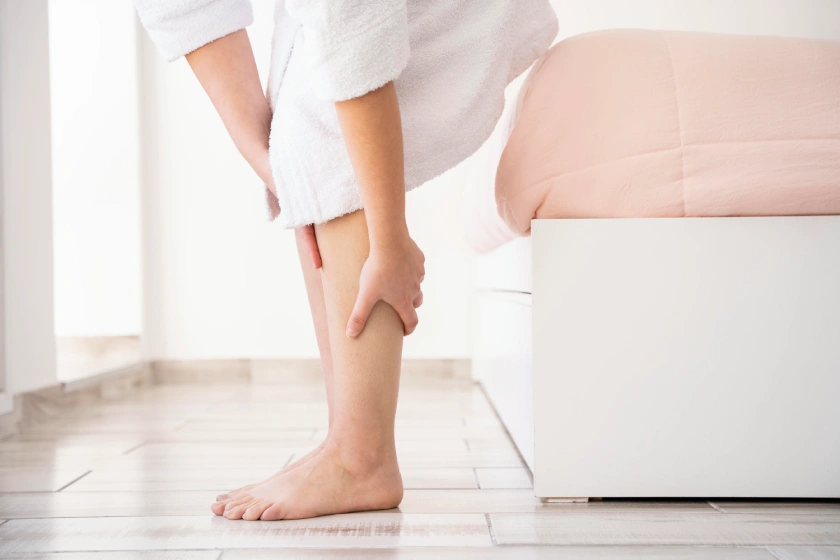
Swollen legs and feet are something almost everyone experiences at some point — after a long day of standing, a tiring journey, or even in hot weather. But when the swelling becomes a regular visitor, it’s your body’s way of asking for attention. Sometimes it’s harmless and goes away with rest.
Other times, it’s a sign of an underlying issue with circulation, veins, or even your heart or kidneys. The good news? Gentle, regular exercises can make a real difference. I have seen patients regain comfort, mobility, and confidence simply by making movement a part of their daily routine.
What is Leg Swelling?
Leg swelling, or edema, happens when excess fluid collects in the tissues of your legs and feet. The reasons can range from sitting too long at your desk to medical conditions like varicose veins, chronic venous insufficiency, or deep vein thrombosis (DVT).
It might also be linked to certain medications, pregnancy, or organ-related health issues. Sometimes the swelling is accompanied by heaviness, discomfort, or changes in skin colour.
The first step is understanding why it’s happening, and the second is taking the right steps, quite literally, to improve your circulation.
Top Exercises to Reduce Leg Swelling
Lying Down Trunk Rotation
Lie on your back with your knees bent and feet flat. Slowly lower both knees to one side while keeping your shoulders touching the floor. Hold for a moment, return to the centre, and repeat on the other side. This movement gently stretches your spine and hips, improving circulation and helping trapped fluid move out of your legs.
Knee Extension Kicks
Sit on a sturdy chair with both feet flat. Straighten one leg out in front of you, hold for a few seconds, and bring it back down. Repeat several times before switching legs. This simple exercise strengthens your thigh muscles, which in turn act as pumps to send blood back toward your heart. It’s ideal for those who spend hours at a desk or in front of a screen.
Laying Down Ankle Pumps
While lying down, point your toes away from you and then flex them back toward you. Keep the movement rhythmic for 1–2 minutes. This is one of the best exercises for swelling in the legs and feet because the calf muscles play a key role in pushing fluid and blood upward against gravity.
Mini Squats
Stand with your feet shoulder-width apart, holding onto a chair or wall for balance. Bend your knees slightly — just enough to feel the muscles in your thighs working — and then stand back up. Mini squats build muscle strength, improve joint flexibility, and keep blood moving through the larger vessels in your legs.
Walking
Few things are as underrated as walking. A brisk 15–20 minute walk twice a day not only strengthens your muscles but also encourages better blood flow, reduces stiffness, and helps your heart and lungs. Even if you cannot walk fast, regular movement is far better than staying still.
Conclusion – A Note from Dr. Sumit Kapadia
As a vascular surgeon, I can tell you that your legs often reveal the truth about your circulation before any scan does. Swelling in the legs is not something to ignore, especially if it keeps coming back.
These exercises are not just movements; they are an investment in your vascular health. By keeping your blood flowing and your muscles active, you give your body the best chance to heal naturally and avoid more serious problems down the road.
If swelling does not improve, worsens, or is accompanied by pain, skin changes, or sudden discomfort, do not delay seeking medical advice.
My team and I at Aadicura Hospital are here to find the root cause and offer the best treatment for swollen legs, whether it’s through lifestyle changes, medical therapy, or advanced vascular procedures. Remember, healthy circulation is the foundation of a healthy life. Let’s keep your legs moving, your blood flowing, and your health in motion.
Frequently Asked Questions
Ankle pumps are highly effective because they activate the calf muscles, which help push fluid and blood upward toward the heart.
Stay active, avoid long periods of sitting or standing, elevate your legs, wear compression stockings, and perform exercises such as walking or ankle pumps regularly.
Regular exercise, hydration, quitting smoking, and keeping your weight in check can improve leg circulation.
Vitamin C and Vitamin E support blood vessel health, while Vitamin B-complex helps maintain healthy nerve and muscle function. Always consult a doctor before starting supplements.

Dr. Sumit Kapadia
MBBS, MS, MRCS, DNB-Fellow



